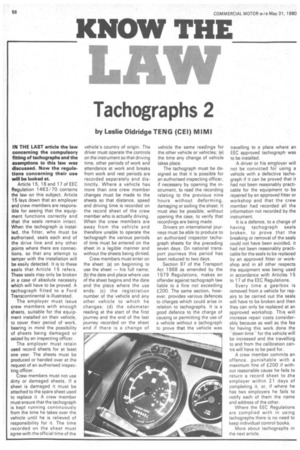KNOW THE
Page 58

If you've noticed an error in this article please click here to report it so we can fix it.
Tachographs 2
by Leslie Oldridge TENG (CEI) MIMI
IN THE LAST article the law concerning the compulsory
fitting of tachographs and the exemptions to this law was discussed. Now the regulations concerning their use will be looked at.
Article 15, 16 and 17 of EEC Regulation 1463/70 contains the law on this subject. Article 15 lays down that an employer and crew members are respons ible for seeing that the equip ment functions correctly and that the seals remain intact.
When the tachograph is instal led, the fitter, who must be authorised, seals each end of the drive line and any other points where there are connections, so that any attempt to tamper with the installation will be easily detected. It is to these seals that Article 15 refers.
These seals may only be broken in a case of absolute necessity which will have to be proved. A tachograph fitted to a Ford Transcontinental is illustrated.
The employer must issue crew members with enough sheets, suitable for the equip ment installed on their vehicle, to cover their period of work, bearing in mind the possibility of sheets being damaged or seized by an inspecting officer.
The employer must retain used record sheets for at least one year. The sheets must be produced or handed over at the request of an authorised inspecting officer.
Crew members must not use dirty or damaged sheets. If a sheet is damaged it must be attached to the spare sheet used to replace it. A crew member must ensure that the tachograph is kept running continuously from the time he takes over the vehicle until he is relieved of responsibility for it. The time recorded on the sheet must agree with the official time of the vehicle's country of origin. The driver must operate the controls on the instrument so that driving time, other periods of work and attendance at work and breaks from work and rest periods are recorded separately and distinctly. Where a vehicle has more than one crew member changes must be made to the sheets so that distance, speed and driving time is recorded on the record sheet of the crew member who is actually driving. When the crew members are away from the vehicle and therefore unable to operate the tachograph the various periods of time must be entered on the sheet in a legible manner and without the sheets being dirtied.
Crew members must enter on the sheet: (a) on beginning to use the sheet — his full name; (b) the date and place where use of the sheet begins and the date and the place where the use ends; (c) the registration number of the'vehicle and any other vehicle to which he changes; (d) the odometer reading at the start of the first journey and the end of the last journey recorded on the sheet and if there is a change of vehicle the same readings for the other vehicle or vehicles; (e) the time any change of vehicle takes place.
The tachograph must be designed so that it is possible for an authorised inspecting officer, if necessary by opening the instrument, to read the recording relating to the previous nine hours without deforming, damaging or soiling the sheet. It must also be possible, without opening the case, to verify that recordings are being made.
Drivers on international journeys must be able to produce to an authorised inspector tachograph sheets for the preceding seven days. On national transport journeys this period has been reduced to two days.
Section 97 of the Transport Act 1968 as amended by the 1979 Regulations, makes an offender against tachograph law liable to a fine not exceeding £200. The same section, however, provides various defences to charges which could arise in relation to tachographs. It is a good defence to the charge of causing or permitting the use of a vehicle without a tachograph. to prove that the vehicle was travelling to a place where an EEC approved tachograph was to be installed.
A driver or his employer will not be convicted for using a vehicle with a defective tacho graph if it can be proved that it had not been reasonably practi cable for the equipment to be repaired by an approved fitter or workshop and that the crew member had recorded all the information not recorded by.the instrument.
It is a defence, to a charge of having tachograph seals broken, to prove that the breaking or removal of the seals could not have been avoided, it had not been reasonably practi cable for the seals to be replaced by an approved fitter or work shop and in all other respects the equipment was being used in accordance with Articles 15 to 17 of the EEC Regulations.
Every time a gearbox is removed from a vehicle for rep airs to be carried out the seals will have to be broken and then they can only be replaced at an approved workshop. This will increase repair costs considerably because as well as the fee for having this work done the ''down time' for the vehicle will be increased and the travelling to and from the calibration centre will have to be paid for.
A crew member commits an offence, punishable with a maximum fine of £200 if with out reasonable cause he fails to return a record sheet to The employer within 21 days of completing it, or, if where he has two employers he fails to notify each of them the name and address of the other.
Where the EEC Regulations are complied with in using tachographs there is no need to keep individual control books.
More about tachographs in the next article.




























































































































